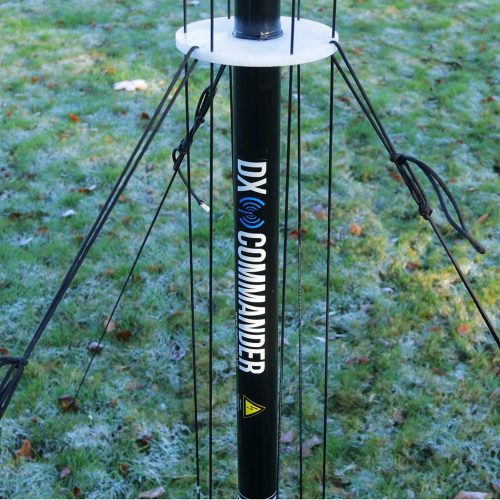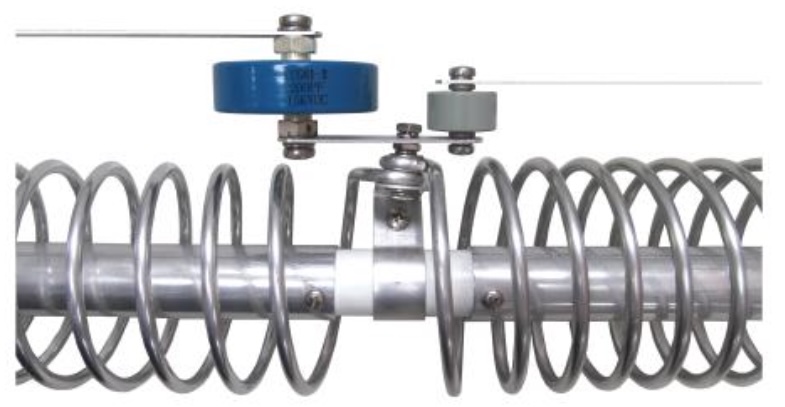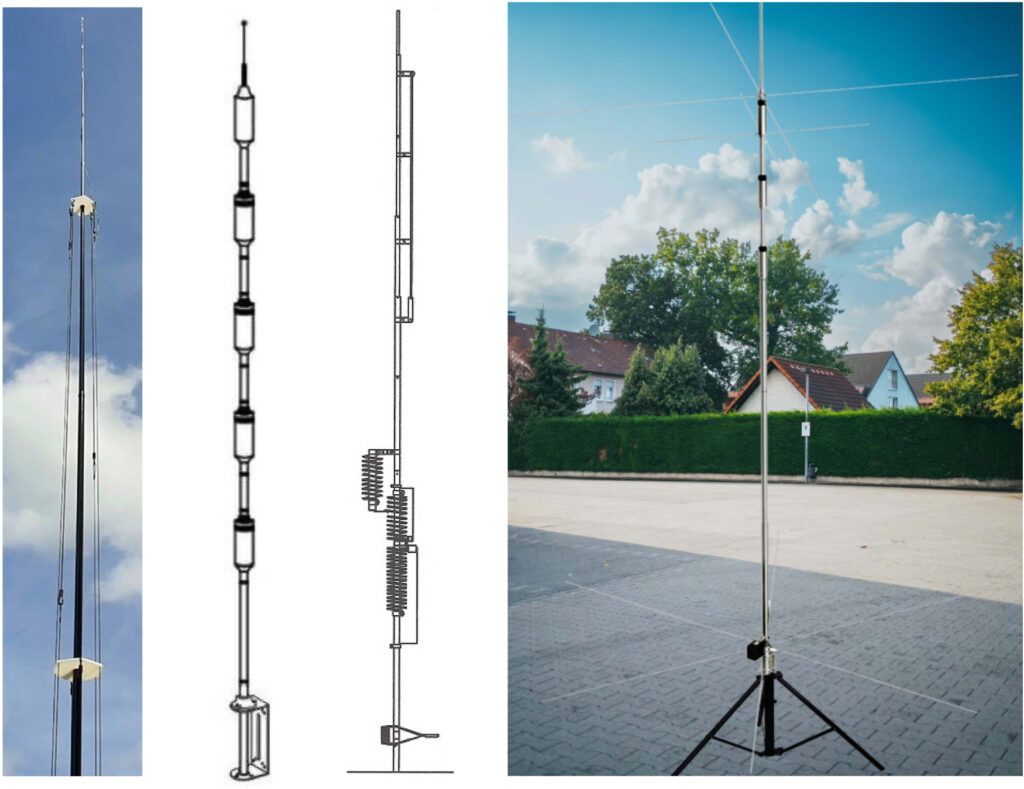by Gary Johnson NA6O
A holy grail for many hams is an antenna that’s usable on nearly all bands that takes up very little room. This time we’re talking multi-band verticals. While compromised in several ways, they at least get us on the air. For this survey, we’ll only consider the contraptions that are resonant on their supported bands (without adjustment) as opposed to the non-resonant ones that are heavily reliant on an antenna tuner, such as a 43-foot vertical.
What About Radials?
Every vertical antenna has an associated ground radial system, sometimes called a counterpoise. When dealing with multiple bands, an effective solution is ground-based radials which are non-resonant. The drawback is that you have to deploy quite a few long wires in your yard in order to achieve good efficiency (radials provide a low-loss return path instead of the lossy Earth). Another solution could be elevated radials which are resonant, but that would mean that you need separate wires for each band, and that’s quite a cobweb. Yet another solution is an off-center fed vertical dipole (OCFVD) where the radials are a single, fixed length, and need not be very long. We’ll review a couple of designs like that.
Some Models That Use Ground Radials
Reminder: All of these antennas require a robust ground radial system in order to maintain efficiency. See the ARRL Antenna Book for some design recommendations and tradeoffs for ground radials.
DX Commander [Ref. 1] offers several models that use ground-based radials covering everything from 80 through 2m. For the vertical elements, they use an array of parallel 1/4-wavelength wires, making this the vertical equivalent of a fan dipole and nicely resonant on all bands. This is electrically very simple with no traps or elaborate mechanical contraptions though some elements fold back or have small loading inductors. Their kits include plastic guides that keep the wires parallel (Figure 1). Assuming you can put down an adequate radial field, this will be an efficient antenna with good bandwidth on each band. A drawback is that it’s going to be tall, e.g., 33 ft for 40m. They do have a loading kit for 80m to keep it from ending up in the stratosphere. Overall, I really like these antennas because of their straightforward design, efficiency, bandwidth, and power handling.

Hustler is an old brand (now owned and sold by DX Engineering) of trapped verticals that require ground-based radials. For instance, the 6BTV covers 10, 15, 20, 30, 40, and 80m and is only 24 ft tall. There are five traps in series which add inductance thus shortening the antenna on the lower bands. They are rated for high power (1 kW CW) and have reasonable SWR bandwidth except on 80m where it’s roughly 80 kHz (2:1), which is typical of any shortened antenna. The only issue I have is loss in the traps and the possibility of trap failure with weather and time.
Butternut is another older company now owned by DX Engineering offering a 6- and a 9-band version. The HF6V covers 10, 15, 20, 30, 40, and 80m and is 26 ft tall. They use several interesting tricks including loading coils, traps, and transmission line matching sections. Their traps are pretty serious, being made of large aluminum tubing and low-loss ceramic capacitors (Figure 2). This minimizes loss and fully supports high power. Once again its reduced height means bandwidth will be limited on 40m (150 kHz, 2:1) and 80m (<80 kHz). Like all complex multi-band verticals, plan on spending some time with an antenna analyzer and your toolkit to adjust the SWR on each band per the instructions. And if you choose the big brother with nine bands, tuning may be even more interesting. Overall, this is another solid though complex antenna design.

The OCFVD Vertical
Hy-Gain and Cushcraft made a number of popular models based on off-center fed vertical dipoles such as the R6000, R9 and AV640, but with the demise of MFJ, they are only available on the used market. Today there are a couple of other companies making antennas of this type that we’ll cover. But first, how do these antennas work?
As an antenna hacker, my hat is off to the folks who designed these OCFVD contraptions using an arsenal of tricks. We begin with an off-center feed point. On the short end (nearer to the ground), add a set of radials of modest length, commonly about 6 ft long and made of stainless steel.
Like an OCF dipole, you can experimentally find a place near one end that yields a similar impedance on all the desired bands. It’s similar on all bands, but not 50 ohms, so you add a matching transformer to yield a reasonable SWR.
To improve the match on various bands, add some traps. These effectively cut off the far end of the antenna at their resonant frequency. They also act as an inductor at other frequencies, shortening the antenna. Traps can also be added to the radials.
Next, add some capacitance hats near the top of the antenna. These are a low-loss method of lengthening the antenna. Length of the capacity hat wires is another tuning element. And by placing them between traps, you can tune particular bands. A Christmas tree is born.
Finally, you can add one or more coupled resonator, or open-sleeve elements. These are typically 1/4 wavelength pieces of tubing that may or may not be directly connected to the rest of the antenna. Because they are resonant they literally “suck the power” away from the rest of the antenna structure on a specific band.
Somehow the crafty designer combines some or all of these elements into a reproducible package. A drawback of this complexity is that it can be tricky to tune in the field because some of the elements interact.
I should also mention that, being an off-center fed antenna, the outside of your coax must be isolated via a robust common-mode choke. Most of the commercial antennas include this in their matching box. The matching transformer is also under some stress and between that and the choke, quite often you will find power limitations due to overheating. Running high power, you may see the SWR start to rise. Keep going, and the whole matching unit will eventually melt!

Some OCFVD Models
Chelegance model KC4 [Ref. 2] covers 40, 20, 15, and 10m and is 26 ft long with 9 ft radials. They use three traps in the vertical plus capacitance hats. It has limited power handling, such as 500 W on CW, which indicates that the matching system is under stress and probably dissipates a bit of energy, typical of this kind of antenna. It’s pretty light (16 lbs) and doesn’t take up too much space. Mount it up on a pole as high as you can. This may be the only viable OCFVD antenna on the market at the moment.
Diamond Antenna model CP6AR covers 75, 40, 20, 15, 10, and 6m. It uses three traps plus capacitance hats and, unusually, tuned radials with traps. It’s only 13 ft tall and radials are 6 ft long. Because it’s so short, SWR bandwidth and power handling a highly compromised. For instance on 75m, bandwidth is only about 20 kHz and on 40m about 30 kHz. Also, it’s only rated 70W CW. Clearly there’s an efficiency problem in the matching box, likely qualifying this antenna as an “outdoor dummy load.” The old Cushcraft antennas were taller but way better!
Installation Tips
Install guys: Many verticals require guys and they are most recommended in windy locations. Thankfully the wind loading isn’t too severe so the guy anchors can usually be something simple like a piece of pipe driven in the ground, or a heavy eye bolt attached to the house, fence, or tree. Dacron rope is recommended for long lifetime in the sun.
Use an antenna analyzer: Don’t try tuning up one of theses complex multi-band antennas without an antenna analyzer or it will take forever. You will have to raise and lower the antenna several times.
Elevate the base: If your chosen vertical does not use ground-based radials, it is very desirable to elevate the base of the antenna on some kind of mast or mount it on your roof. This will lower the takeoff angle and increase gain for better DX [Ref. 3]. Ideally the mast would be non-conductive but most of us just use some pipe.
Advantages and Disadvantages
As stated at the opening of this article, the reason for choosing an antenna like this is that you get multiple bands in a fairly compact installation, give or take some ground radials which at least you can hide. Efficiency is your main concern, followed by usable bandwidth, and some of the models we looked at are compromised in either or both aspects, so choose wisely. And like any vertical, we joke that they radiate “equally poorly in all directions,” but seriously, any antenna is better than no antenna.
References
- DX Commander website https://dxcommander.com/
- Chelegance KC4 Antenna https://chelegance.com/products/cntou-kc4-shortwave-4-band-vertical-antenna/
- Jim Brown, K9YC, “If I Could Put My HF Vertical On My Roof, Should I?” http://www.audiosystemsgroup.com/VerticalHeight.pdf
